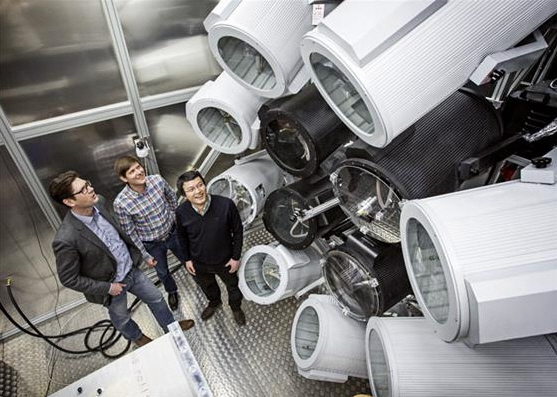Yet not everywhere in Sweden is so bleak. Because there are so few solar laboratories in the world, KTH Royal Institute of Technology reasoned that Stockholm was the perfect place to build one and in there, the future is bright 24 hours a day.
It officially opens this week, and is a tribute to modern engineering, but solar collectors are not new. Legend has it that in the siege of Syracuse, between 212 and 214 B.C., Archimedes concentrated solar energy through mirrors directed against enemy ships. His 'death ray caused the sails to burn and the ships to sink. Imagine what he could do with today's technology.
The inside of the laboratory resembles a square tin. All surfaces are covered with metal that can handle the power, radiation and heat, which can easily climb to 2,000 C degrees. The plant is controlled from a control panel outside the laboratory. Apart from computer screens, you can follow the experiments with the naked eye through small peepholes of reinforced glass on one side. Twelve extremely powerful spotlights simulate the sun at 7 kilowatts each, generating and shining light on a small area of 20 square centimeters.

KTH Solar Lab. Photo: Håkan Lindgren
By using different types of lenses, loupes and filters they can experiment with and concentrate solar energy in different ways, which creates a light output of up to 6.7 megawatts per square meter.
"The solar energy in here is 6,000 times stronger than the way we experience the sun on the earth," says Björn Laumert, associate professor at the Department of Energy Technology at the School of Industrial Engineering and Management.
The light is converted to heat in a receiver that drives a gas or steam turbine alternatively, via a Stirling engine, which in turn generates electricity or heat. Unlike solar cells that convert light into electricity directly, the concentrated solar energy can be stored as heat and used even when the sun does not shine. Storage, cost, and conversion are the central challenges in order to use solar power as a sustainable resource.
KTH's Solar Lab will primarily be used for research into solar power and solar receivers. However, the laboratory will also be used for basic research on high temperature materials, as used in the construction of rocket engines or fusion reactors, and to investigate chemical reactions under high light output.





Comments